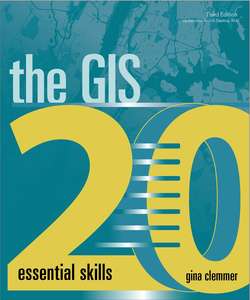Читать книгу The GIS 20 - Gina Clemmer - Страница 25
На сайте Литреса книга снята с продажи.
Оглавление| CHAPTER 2 | KEY CONCEPTSworking with multiple layerschanging map colorscreating labelscreating layoutscreating legendscreating titlesusing scale barsusing north arrows |
Creating basic maps and layouts
Reference maps are basic, traditional maps like those you see in atlases. Their purpose is to illustrate geographic boundaries of a given area, such as cities or counties. These types of maps are the cornerstone of cartography. Layouts contain titles, legends, north arrows, scale bars, and many other graphic features. It is important that you learn to create layouts that help your reader quickly understand your map.
In this exercise, you will make your first map.
[ You will need to download all chapter data files from esri.com/GIS20-3.
Creating a reference map
A key point of this exercise is to teach you to effectively color-shade and label multiple layers in a map. In this example, counties and cities are used.
Open the project
1 1.Open ArcMap. (If you don’t know how to do that, see chapter 1, “Open ArcMap.”) Unlike adding a shapefile to ArcMap, here you must open your saved project. To do that, click File (upper left), then click Open, and then navigate to your save folder. Select mystate.mxd. (If you are unable to find this file, you can access a similar one in the data files at esri.com/GIS20-3, in the chapter 2 folder.)
Change layer colors
Change the layers’ colors (color, fill, outline), which is called “changing the symbology” in ArcMap, so you can easily see each layer in the map.
For the county layer, follow these steps:
1 1.In the table of contents, right-click the county file layer name, and then click Properties. By the way, “right-click > properties” is the answer to nearly every question going forward.
2 2.Click the Symbology tab. Click the big color swatch under Symbol.
1 3.Click the hollow color swatch on the left. For the outline color, located slightly below the Fill Color option on the right, select a medium gray. Click OK twice.
TIP “Hollow” makes the layer transparent so you can see the layer underneath it. “Hollow” and “No Color” are one and the same. For many shapefiles, gray is a better choice than black for the outline because it puts less ink on the page, which will make maps easier to read.
For the cities layer, follow these steps:
1 4.In the table of contents, right-click Cities, and then click Properties. (Assuming you changed the layer name in the last exercise. If you did not, this is the place shapefile.)
2 5.Click the Symbology tab, and then click the big color swatch under Symbol.
3 6.Click the Fill Color button on the right side, and select a bright green to symbolize cities. A good option here is Light Apple, which is the seventh column over, second row down (hovering over the color swatch displays the color name).
4 7.For outline color, select No Color. By taking off the outline color, you make the map easier to read. Click OK twice.
Make a layer semitransparent
1 1.In the table of contents, right-click the Cities layer, and then click Properties.
2 2.Click the Display tab.
3 3.On the right of Transparent, type 50. This designation will make the Cities layer 50 percent transparent, allowing you to see through it. Click OK. Notice how the layer is lighter. You did not need to make this layer semitransparent; however, it makes the map slightly easier to read and teaches a new skill.
Reorder layers
1 1.In the table of contents, drag the county layer into first position. If you are unable to do this, ensure that you select List By Drawing Order (the first button) in the table of contents. This step makes a subtle change. The counties are in the top layer, with light-gray lines, and the semitransparent cities are displayed underneath.
TIP For a reference map, it is difficult to illustrate more than four layers on one map without the map becoming too cluttered.
Turn on labels
Labeling is essential to creating a quality reference map. So now you can label cities.
1 1.In the table of contents, right-click the layer you want to label (Cities), and then click Properties.
2 2.Click the Labels tab. Select the “Label features in this layer” box, which is a tiny little check box in the upper-left corner. The appropriate field for labeling is already selected by default (Name).
1 3.Click OK, and have a look at the labels. What a mess! Now you can fix these labels, and make the map easier to read.
Fix labels
You can do many things to improve messy labels:
■Remove duplicate labels.
■Assign a buffer to labels, which places only some of the labels.
■Create a halo (a white outline) around labels.
To remove duplicate labels, complete the following steps:
1 1.In the table of contents, right-click Cities, and then click Properties.
2 2.Click the Labels tab.
3 3.In the lower-left corner, click Placement Properties.
1 4.At the top, click the Placement tab.
2 5.Select the Remove Duplicate Labels option.
To assign buffers to labels, complete the following steps:
1 6.At the top, click the Conflict Detection tab.
2 7.Toward the bottom of the menu is an option to assign a buffer number. Type 2 in the provided field, and then click OK twice. This buffering will place only some labels on the map, making it much easier to read.
To create a halo around labels, complete the following steps:
